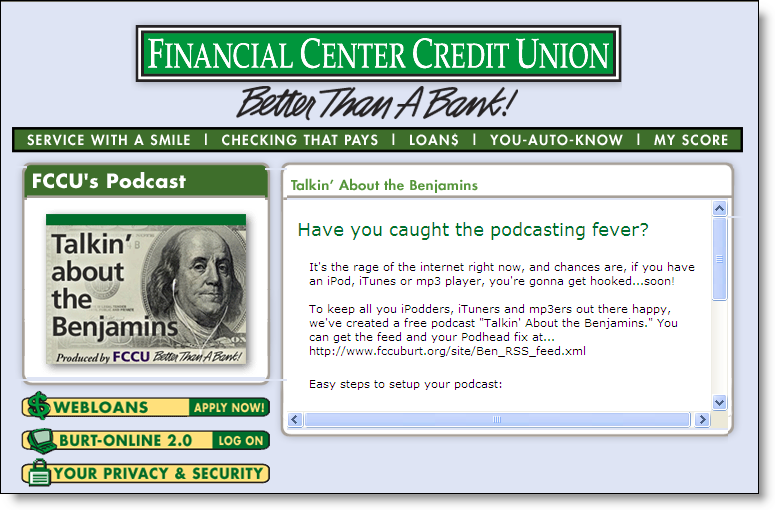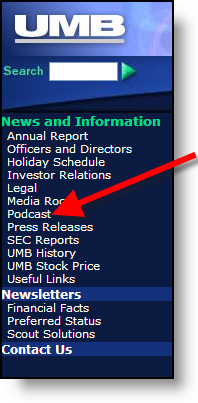 Podcast was voted the 2005 Word of the Year by New Oxford American Dictionary. That alone is enough to make it an interesting marketing technique, even though it’s more associated with music than banking.
Podcast was voted the 2005 Word of the Year by New Oxford American Dictionary. That alone is enough to make it an interesting marketing technique, even though it’s more associated with music than banking.
So far, two U.S. financial institutions have jumped on the podcasting bandwagon:
- The first financial podcaster was Stockton, CA-based Financial Center Credit Union <fccuburt.org>. Its rambling, 56-minute first effort, Personal Finance Tips, from CEO Michael Duffy, was posted on Apple’s iTunes on August 30. The program is more philosophical than factual and sounds almost unscripted, as if the CEO just sat down and talked about whatever came to mind for an hour. It’s hard to imagine anyone other than his mother or marketing manager listening to the whole thing. Since then, they’ve published two more installments of the series: a 31-minute Personal Finance Tips, posted Oct 17, and a nine-minute discussion of phishing and pharming on Dec. 14. The latter program, which did NOT feature the CEO, was a more appropriate length and dealt with facts and actionable information.
– While the content is of questionable value, the website design is good, positioning the CU as hip and with it. The podcast series is entitled, Talkin’ About the Benjamins, and features a clever visual of Ben Franklin with the signature Apple earphones on his head (see inset above left). The credit union has a link on its homepage to a dedicated podcast page (click on inset above for closeup) that explains how to subscribe to the series via Apple’s iTunes site or to download directly from the CU site in MP3 format.
While the content is of questionable value, the website design is good, positioning the CU as hip and with it. The podcast series is entitled, Talkin’ About the Benjamins, and features a clever visual of Ben Franklin with the signature Apple earphones on his head (see inset above left). The credit union has a link on its homepage to a dedicated podcast page (click on inset above for closeup) that explains how to subscribe to the series via Apple’s iTunes site or to download directly from the CU site in MP3 format.
– - The first bank to post a podcast was UMB Bank <umb.com> out of Kansas
 City. The first of the three planned recordings was posted Dec. 5, The Ins and Outs of 401(k) Retirement Plans. The bank also makes its podcast available for free downloading at the iTunes store or directly at the bank’s website. The recording is a question-and-answer session with UMB Portfolio Manager Casey Matthews. The UMB program is also relatively amateurish, with the participants nervously chuckling at their own jokes. At more than 24 minutes, it’s too long, but for a listener with little knowledge of retirement plans, it’s not a bad educational program.
City. The first of the three planned recordings was posted Dec. 5, The Ins and Outs of 401(k) Retirement Plans. The bank also makes its podcast available for free downloading at the iTunes store or directly at the bank’s website. The recording is a question-and-answer session with UMB Portfolio Manager Casey Matthews. The UMB program is also relatively amateurish, with the participants nervously chuckling at their own jokes. At more than 24 minutes, it’s too long, but for a listener with little knowledge of retirement plans, it’s not a bad educational program.
In contrast to the marquee placement of FCCU’s podcasts, UMB bank buries the program in the middle of a long list of content within the News and Information part of the website (click on inset above for a closeup). This considerably diminishes the marketing value.
Analysis
The question isn’t really whether to podcast or not, but rather whether audio/visual content should be added to your website. The answer to the second question is a resounding YES. It’s time to leverage the high-speed Internet connections enjoyed by the majority of your customers with professional audio and video content. There are numerous programming tools that can be used; the most common is Macromedia FLASH, to develop good audio and video programming.
There isn’t really a pressing need to provide the information in the proprietary iPod format. The number of users who will want to download your sales pitch and listen to it on the train ride home can be counted on one hand. However, given the hype surrounding everything iPod, it’s not a bad idea to post your work as an iPod recording.
If you do end up with a podcast, keep these tips in mind:
- Keep it short and to the point: Strive for a tight, overall length of no more than 5 to 10 minutes. If the subject matter needs more time, break the broadcast into multiple parts.
- Make it professional: Listeners expect a degree of professionalism from their bank that they don’t expect from other podcasters. If you can’t afford to hire a pro to develop the program, try tapping into the eager broadcasting majors at a local university or community college. At the very least, develop a script and practice before broadcasting.
- Use a Q&A format: We like UMB’s format, pairing an interviewer with a bank expert. Had they kept to the 10-minute limit, it would have been worth listening to.
- Lose the humor: Banking is serious. It’s OK to use some humor in advertising and promotion, but a broadcast from the bank should not include any attempts at humor, and NO laughing at your own jokes.
- Post it at iTunes: Easily explain how to find it, so that users can quickly subscribe to future broadcasts.
- Most important, marry the audio broadcast with visual aids: UMB’s 24-minute podcast on retirement savings would be much more effective with supporting visuals, especially as they run through several examples of after-tax returns of various investment options. A standard webcast using PowerPoint and an audio presentation would be far more effective, although less likely to land you a write-up in the local newspaper.
—JB